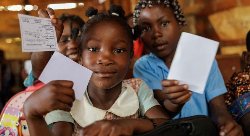UNESCO Fails to Protect World Heritage in Tanzania
UNESCO Fails to Protect World Heritage at Cradle of Mankind
Elephants, Rhinos and the environment are under threat from 60 million tons of radioactive waste as World Heritage Committee agrees boundary change that will allow uranium mining at the Tanzania Selous Game Reserve - a World Heritage site.
Freiburg, Germany - A foreign uranium mining conglomerate will be allowed to exploit the precious Selous Game Reserve in Tanzania after the World Heritage Committee (WHC) decided, at its July 2012 session in Russia, to accept what was described as a "minor boundary change" of the site. The change had been requested by the Government of Tanzania, in order to make way for the development of a major uranium mine, Mkuju River Uranium Project, owned by Russian ARMZ and Canadian Uranium One.
The decision to allow the boundary change would allow the Mkuju River uranium project, situated in the South of the Selous Game Reserve at its transition to the Selous Niassa Wildlife Corridor, to go forward. The Tanzanian Government lobbied heavily for the boundary change, after declaring its intent to "win the battle" against the UNESCO WHC.
Dozens of environmental groups around the world, many of them members of the German-based Uranium Network, decried the WHC decision which could lead to the creation of 60 million tons of radioactive and poisonous waste by the mine during its 10-year lifespan (139 million tons if a projected extension of the mine should be implemented). The radioactive wastes pose a serious threat to Selous Game Reserve which is home to the world’s largest elephant population and other wildlife. No proven methods exist to keep the radioactive and toxic slush and liquids from seeping into surface waters, aquifers or spreading with the dry season wind into the Reserve.
It remains completely unclear how the company or the Government of Tanzania will guarantee that the impact of millions of tons of radioactive and toxic waste will be “limited”. The WHC decision appears to be influenced by heavy corporate and government lobbying and not by sound science. It sets a horrible precedent that could threaten other World Heritage Sites with similar dangerous and damaging exploitation.
The decision is in stark contrast to previous decisions of the WHC of 2011 stating that mining activities would be incompatible with the status of Selous Game Reserve a World Heritage site.
The environmental groups question whether WHC members have fully understood and given adequate attention to the implications of a uranium mine - including diesel generators, uranium mill, housing, heavy truck roads, as well as the creation of millions of tons of radioactive and toxic waste which should be contained safely and separate from the environment for thousands of years.
Uranium mining creates radioactive dust, contaminates waterways and groundwater aquifers and depletes often precious water supplies. Once abandoned, the radioactive contamination from the mines can persist for decades or even hundreds of years.
The WHC's decision was made at a time when Russia was chairing the WHC session in St. Petersburg, Russia; Mkuju River uranium project - which basically lives or dies with the decision on the boundary change - is majority owned by Russian ARMZ, a subsidiary of ROSATOM - who bought it from Australian Mantra Resources earlier in 2012.
The environmental groups urge the World Heritage Committee to reconsider its decision on the Selous Game Reserve Boundary Change and call upon the Government of Tanzania to refrain from licensing a uranium mine in Selous Game Reserve or on lands cut out from it.
Additiona l information
The World Heritage Committee's decision: http://whc.unesco.org/archive/2012/whc12-36com-19e.pdf
The WHC’s decision came about after heavy lobbying by the Tanzanian Government.
Its wording (Point 8 - WHC … "8. Decides in an exceptional and unique manner to approve the proposed boundary modification of the Selous Game Reserve, United Republic of Tanzania";) - suggests strongly that lobbying efforts are the reason behind granting the border change to the Government of Tanzania - not considerations based on scientific evidence and the experience with uranium mining activities in or around World Heritage sites.
The WHC based its “exceptional and unique” decision mainly on an Environmental Impact Statement (EIS) which claims that the impact of the proposed mining project on the Outstanding Universal Value of the World Heritage Site is "limited" and can "be mitigated".
However, the review version of the EIS was handed in by the Tanzanian government after the WHC's deadline. IUCN - which is consulting the WHC - stated that there was not enough time to fully consider the document.
In addition, after repeated breaches of deadlines and procedures, the WHC entrusted the Tanzanian government to fulfill promises on improving the protection of the Selous ecosystem and the Selous-Niassa-Wildlife-Corridor. However, the reality is that the Government of Tanzania has already licensed extensive uranium exploration projects in the Selous-Niassa-Corridor.
The WHC’s provision “…that economic and social needs of the local population and workers are respected and that social conditions in and around the Selous Game Reserve, in particular linked to the Mkuju River Mining site, are subject to monitoring,” (Point 9 b of the decision) sounds suspicious in the face of Tanzania’s experience with gold and other mining activities which adversely impacted the local people’s existence, well-being and their human and civil rights.
Moreover, conditions set by the WHC for allowing the boundary change were not made a pre-requisite for the decision, but are to be met by the Tanzania Government afterwards – with no guarantee at all that they will ever be met.
Deadlines set by the WHC were repeatedly ignored by the Government of Tanzania: a previous Tanzanian minister called the WHC “an irrelevant body,” displaying serious contempt for the Committee.
Thus, it remains more than questionable whether the Government of Tanzania will change its stance towards the WHC.
The Government of Tanzania also argued that the income created by the mining activities would improve the country’s situation especially in regard to healthcare and other social needs.
However, the costs of reclamation of the mining site with its 60 to 139 million tons of radioactive wastes will range from US $417 million to $977 million (extended version of Mkuju River Project).
The costs will be in the range of the income created by the mining activities. Thus, no real “profit” will be made by the Republic of Tanzania.
The WHC's decision is highly alarming since it may be seen by mining companies and Governments as a precedent for circumventing the declared incompatibility of mining activities and the status of places such as World Heritage sites in order to allow mineral exploitation at the expense of the unique value of World Heritage sites.
About the
uranium-network.org
uranium-network.org is dedicated
to informing the world of the hazards of uranium mining. Our
activists have worked on the issue for more than 20
years.
More information at: www.uranium-network.org
ENDS


 UN News: Healing Page By Page In Earthquake-affected Türkiye
UN News: Healing Page By Page In Earthquake-affected Türkiye Save The Children: Rate Of Attacks On Healthcare in Gaza Higher Than In Any Other Conflict Since 2018
Save The Children: Rate Of Attacks On Healthcare in Gaza Higher Than In Any Other Conflict Since 2018 UN News: Green Light For New Cholera Vaccine, Ukraine Attacks Condemned, Action Against Racism
UN News: Green Light For New Cholera Vaccine, Ukraine Attacks Condemned, Action Against Racism Laureus: Grand Slam Champion Garbiñe Muguruza Announces Retirement Ahead Of Laureus World Sports Awards
Laureus: Grand Slam Champion Garbiñe Muguruza Announces Retirement Ahead Of Laureus World Sports Awards Carbon Market Watch: Going For Green - Is The Paris Olympics Winning The Race Against The Climate Clock?
Carbon Market Watch: Going For Green - Is The Paris Olympics Winning The Race Against The Climate Clock? New Zealand Defence Force: NZDF Working With Pacific Neighbours To Support Solomon Islands Election
New Zealand Defence Force: NZDF Working With Pacific Neighbours To Support Solomon Islands Election